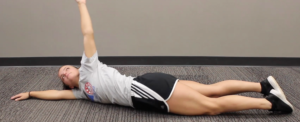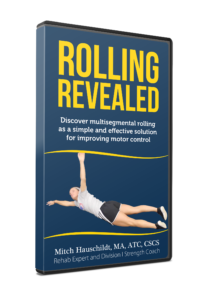 by Mitch Hauschildt, MA, ATC, CSCS
by Mitch Hauschildt, MA, ATC, CSCS
If you have been through one of my Neurofacilitation for Better Movement or Rocktape FMT Performance courses in the past, you know that we spend som
e time getting down on the ground and rolling around. If you haven’t been able to attend one of those courses, you may be wondering, “Why in the world would Mitch have people rolling around on the ground?”
The answer is pretty simple, really. Multisegmental rolling is a fundamental movement pattern that all of us should have the ability to perform and perform well.
As infants, we are all designed to go through multiple neurodevelopmental sequences and patterns that contribute to our overall ability to move. Following the proper sequences as infants is imperative to our development and ensuring that we are able to squat, lunge, press, pull, plank and rotate later in life.
We find that many of our adult athletes who have poor movement patterns can’t roll efficiently. Sometimes this is due to the fact that they skipped over rolling as an infant, or they only rolled one direction. Or, neurologically, th
y may have just forgotten how. Others have developed a mobility restriction or two that hinders their ability to roll. Regardless, rolling has become a staple of my movement training progressions.
Because they don’t teach multisegmental rolling in most ATC, PT, or Exercise Science classes (although they should), I get a lot of questions about it when I teach it and we practice it in my seminars. So, let’s take a quick look at the reasons behind why we roll.
- Neurodevelopmental Sequencing: As I mentioned above, rolling is a big part of how we develop as infants. As we age, it is important that we revisit the patterns and sequences to engrain and re-engrain these basic movement skills. If we follow the same strategies later in life that we use as infa
ts, we find that motor learning is accelerated. Rolling can “prime” the overall system to get it ready for more complex movements. - Eliminates the Prime Movers: In order to roll and roll well, you cannot use your major prime movers. It forces you to use your deeper, stabilizing groups of muscles in your core and trunk to move properly. This is why our large football players struggle to roll. They are used to being prime movers and using high threshold recruitment strategies all of the time. When I strip that away from them, they struggle. This is also what makes it a great training movement for them.
- Combines Mobility with Stabilit
: You have to be mobile and stable to roll well, just like many of the complex movements that we ask our patients to perform on a daily basis. If you are locked up your lats, pecs, thoracic spine or hips (to name a few areas), it will be very difficult to roll. Likewise if you are hypermobile and struggle to turn things on when they need to come on, you won’t be able to roll either. It takes both aspects, making this a great screening movement, as well as a training exercise. - Transverse Plane: The reality is that 95% of us suck in the transverse plane. It’s unfortunate, but true. We don’t resist poor rotation, nor do we create good rotation consistently. Any opportunity that I have to improve how my patients and athletes move in the transverse plane, I’m going to jump on it. Of the 3 planes of motion (frontal, sagittal and transverse), there is more to be gained in the transverse plane than either of the other two. Rolling works in the transverse plane extremely well. Because our patients don’t usually perform well in the transverse plane, we can also identify which of the other two planes they prefer to be in because they will always “dump” in to that plane with their compensation strategies.
I realize that knowing they why is just part of the battle of learning and utilizing new or different strategies. Learning how to teach rolling, what c
mpensation patterns to look for, how to screen to see who is ready to roll and ultimately, how to correct faulty rolling patterns are the next steps to improving motor control and movement skills for your patients and clients.
I have had a ton of requests to film my teaching strategies as it relates to multisegmental rolling for a while now and I’m happy to say that the video has been shot and edited and the final touches are being put on “Rolling Revealed” as I type this. It is over 30 minutes of instructional content solely focused on multisegmental rolling patterns.
I promise to have it out soon, so look for updates in the coming days…


Yea!! I’m very much looking forward to it.
After the last seminar I came home and made myself good and sore working to roll!! Found out I’m totally one sided. Even though I’m not there yet and may never be, I think I feel more “together” from my attempts!! Looking forward to the video and hoping I can use it with some of my clients. Most of us are older but not out of the game!! I love your work!! Thank you for making it available !!